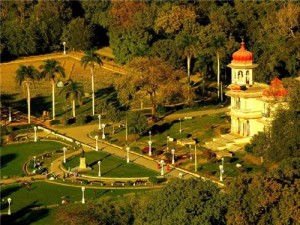 Named after the innumerable types of roses you can spot here, Gulab Bagh is Udaipur’s largest garden. You will not be able to find these roses anywhere in India. Along with the many monuments and spots of historical significance, you need to visit the Gulabh Bagh on your trip to Udaipur. The entire Gulabh Bagh property pans over 100 acres, which means that lovers of flora should allocate a day for this visit. Since Gulabh Bagh is located right below the banks of the Pichola Lake banks, you can incorporate a visit here as part of your Udaipur itinerary.
Named after the innumerable types of roses you can spot here, Gulab Bagh is Udaipur’s largest garden. You will not be able to find these roses anywhere in India. Along with the many monuments and spots of historical significance, you need to visit the Gulabh Bagh on your trip to Udaipur. The entire Gulabh Bagh property pans over 100 acres, which means that lovers of flora should allocate a day for this visit. Since Gulabh Bagh is located right below the banks of the Pichola Lake banks, you can incorporate a visit here as part of your Udaipur itinerary.
The history of Gulab Bagh
Gulab Bagh dates back to 1878, when it was started by Maharana Sajjan Singh. Not only is it Udaipur’s largest garden, but it is also the 4th oldest zoo in the Asian semi-continent. The Maharana’s appointed a horticulturist from Madras to plant and maintain plants of medicinal value on the garden. The garden once saw many flower and vegetable shows, an annual schedule which was initiated in 1888 by Maharana Fateh Singh.
The beauty of Gulabh Bagh
There’s a lotus garden, and you’ll spot many fruit trees including mangoes, guava, grapes, lemon, pomegranate, bananas, sapota, lichi, arjun jack fruit, among others. You’ll also love the heady perfumed smell from flowering trees like jasmine.
Along with the many varieties of roses, it is also the flower bed arrangements that are a thing of beauty. The peaceful ambience and the heady perfume of flowers draws Udaipur residents on a regular basis to spend their weekends here. The garden is pretty safe for kids to explore, and there is a toy train available here that the little ones would love.
Must-see places in the garden include the small horoscope park where plants and herbs are planted to resemble a horoscope and a navigable forest. But you must be ready to walk quite a bit as there are no vehicles allowed inside the garden. Udaipur’s harsh sunlight necessitates a cap, sunglasses and lots of sunscreen.
The zoo of Gulab Bagh
There is a zoo in the property as well. During India’s more princely era, the zoo used to organise fights between lions, tigers and wild boars. It was home to rare species like Black Leopards and Rhinos. After India achieved Independence, these animals were transferred to other zoos in India. Birdwatchers will be able to spot ostriches, pelicans, peacock, parrots, and other and other birds.
Saraswati Bhawan Library
The Maharana placed the foundation stone of the Victoria museum here (which is known as the Saraswati Bhawan Library) in the garden in 1890. You can find books related to history, archaeology, Indology, as well as ancient manuscripts. While you can browse these books, only members can borrow them.
The Gulab Bagh museum
Formerly known as the Victoria Hall Museum, you can find a fine collection of antiques, curios, royal household items and other historical items.
Transportation
Visitors can reach Gulab Bagh by taxi, auto, cycle rickshaw and even a tonga.
